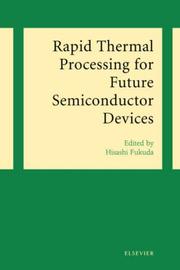| Listing 1 - 6 of 6 |
Sort by
|

ISBN: 9780444513397 0444513396 9780080540269 0080540260 9786611019075 1281019070 Year: 2003 Publisher: Amsterdam London Elsevier
Abstract | Keywords | Export | Availability | Bookmark
 Loading...
Loading...Choose an application
- Reference Manager
- EndNote
- RefWorks (Direct export to RefWorks)
This volume is a collection of papers which were presented at the 2001 International Conference on Rapid Thermal Processing (RTP 2001) held at Ise Shima, Mie, on November 14-16, 2001. This symposium is second conference followed the previous successful first International RTP conference held at Hokkaido in 1997. The RTP 2001 covered the latest developments in RTP and other short-time processing continuously aiming to point out the future direction in the Silicon ULSI devices and II-VI, III-V compound semiconductor devices.This book covers the following areas: advanced MOS gate stack, i
Semiconductors --- Rapid thermal processing --- Rapid thermal annealing --- Rapid thermal process --- Crystalline semiconductors --- Semi-conductors --- Semiconducting materials --- Semiconductor devices --- Crystals --- Electrical engineering --- Electronics --- Solid state electronics --- Heat treatment --- Materials

ISBN: 0792340116 9780792340119 9048146968 9401587116 Year: 1995 Volume: 318 Publisher: Dordrecht Kluwer
Abstract | Keywords | Export | Availability | Bookmark
 Loading...
Loading...Choose an application
- Reference Manager
- EndNote
- RefWorks (Direct export to RefWorks)
Rapid thermal processing --- Heat treatment --- Semiconductors --- Crystalline semiconductors --- Semi-conductors --- Semiconducting materials --- Semiconductor devices --- Rapid thermal annealing --- Rapid thermal process --- Crystals --- Electrical engineering --- Electronics --- Solid state electronics --- Materials --- Semiconductors - Heat treatment - Congresses --- Rapid thermal processing - Congresses
Book
Year: 2020 Publisher: Basel, Switzerland MDPI - Multidisciplinary Digital Publishing Institute
Abstract | Keywords | Export | Availability | Bookmark
 Loading...
Loading...Choose an application
- Reference Manager
- EndNote
- RefWorks (Direct export to RefWorks)
Energy crises and global warming pose serious challenges to researchers in their attempt to develop a sustainable society for the future. Solar energy conversion is a remarkable, clean, and sustainable way to nullify the effects of fossil fuels. The findings of photocatalytic hydrogen production (PCHP) by Fujishima and Honda propose that “water will be the coal for the future”. Hydrogen is a carbon-free clean fuel with a high specific energy of combustion. Titanium oxide (TiO2), graphitic-carbon nitride (g-C3N4) and cadmium sulfide (CdS) are three pillars of water splitting photocatalysts owing to their superior electronic and optical properties. Tremendous research efforts have been made in recent years to fabricate visible or solar-light, active photocatalysts. The significant features of various oxide, sulfide, and carbon based photocatalysts for cost-effective hydrogen production are presented in this Special Issue. The insights of sacrificial agents on the hydrogen production efficiency of catalysts are also presented in this issue.
Technology: general issues --- photocatalysis --- H2 generation --- water splitting --- solar energy --- hydrogen production --- methanol photo-splitting --- heterojunction --- CuS@CuGaS2 --- electron-hole recombination --- perovskite oxynitride --- band gap --- density-functional theory --- Niobium(V) oxide --- graphitic carbon nitride --- hydrothermal synthesis --- H2 evolution --- heterostructures --- Z-Scheme --- TiO2 --- g-C3N4 --- CdS --- energy --- spherical particle --- disordered surface --- photocatalysts --- MoS2 --- MoSe2 --- photoelectrochemical deposition --- rapid-thermal annealing --- hydrogen evolution --- CO2 reduction --- n/a
Book
Year: 2020 Publisher: Basel, Switzerland MDPI - Multidisciplinary Digital Publishing Institute
Abstract | Keywords | Export | Availability | Bookmark
 Loading...
Loading...Choose an application
- Reference Manager
- EndNote
- RefWorks (Direct export to RefWorks)
Energy crises and global warming pose serious challenges to researchers in their attempt to develop a sustainable society for the future. Solar energy conversion is a remarkable, clean, and sustainable way to nullify the effects of fossil fuels. The findings of photocatalytic hydrogen production (PCHP) by Fujishima and Honda propose that “water will be the coal for the future”. Hydrogen is a carbon-free clean fuel with a high specific energy of combustion. Titanium oxide (TiO2), graphitic-carbon nitride (g-C3N4) and cadmium sulfide (CdS) are three pillars of water splitting photocatalysts owing to their superior electronic and optical properties. Tremendous research efforts have been made in recent years to fabricate visible or solar-light, active photocatalysts. The significant features of various oxide, sulfide, and carbon based photocatalysts for cost-effective hydrogen production are presented in this Special Issue. The insights of sacrificial agents on the hydrogen production efficiency of catalysts are also presented in this issue.
photocatalysis --- H2 generation --- water splitting --- solar energy --- hydrogen production --- methanol photo-splitting --- heterojunction --- CuS@CuGaS2 --- electron-hole recombination --- perovskite oxynitride --- band gap --- density-functional theory --- Niobium(V) oxide --- graphitic carbon nitride --- hydrothermal synthesis --- H2 evolution --- heterostructures --- Z-Scheme --- TiO2 --- g-C3N4 --- CdS --- energy --- spherical particle --- disordered surface --- photocatalysts --- MoS2 --- MoSe2 --- photoelectrochemical deposition --- rapid-thermal annealing --- hydrogen evolution --- CO2 reduction --- n/a
Book
Year: 2020 Publisher: Basel, Switzerland MDPI - Multidisciplinary Digital Publishing Institute
Abstract | Keywords | Export | Availability | Bookmark
 Loading...
Loading...Choose an application
- Reference Manager
- EndNote
- RefWorks (Direct export to RefWorks)
Energy crises and global warming pose serious challenges to researchers in their attempt to develop a sustainable society for the future. Solar energy conversion is a remarkable, clean, and sustainable way to nullify the effects of fossil fuels. The findings of photocatalytic hydrogen production (PCHP) by Fujishima and Honda propose that “water will be the coal for the future”. Hydrogen is a carbon-free clean fuel with a high specific energy of combustion. Titanium oxide (TiO2), graphitic-carbon nitride (g-C3N4) and cadmium sulfide (CdS) are three pillars of water splitting photocatalysts owing to their superior electronic and optical properties. Tremendous research efforts have been made in recent years to fabricate visible or solar-light, active photocatalysts. The significant features of various oxide, sulfide, and carbon based photocatalysts for cost-effective hydrogen production are presented in this Special Issue. The insights of sacrificial agents on the hydrogen production efficiency of catalysts are also presented in this issue.
Technology: general issues --- photocatalysis --- H2 generation --- water splitting --- solar energy --- hydrogen production --- methanol photo-splitting --- heterojunction --- CuS@CuGaS2 --- electron-hole recombination --- perovskite oxynitride --- band gap --- density-functional theory --- Niobium(V) oxide --- graphitic carbon nitride --- hydrothermal synthesis --- H2 evolution --- heterostructures --- Z-Scheme --- TiO2 --- g-C3N4 --- CdS --- energy --- spherical particle --- disordered surface --- photocatalysts --- MoS2 --- MoSe2 --- photoelectrochemical deposition --- rapid-thermal annealing --- hydrogen evolution --- CO2 reduction --- photocatalysis --- H2 generation --- water splitting --- solar energy --- hydrogen production --- methanol photo-splitting --- heterojunction --- CuS@CuGaS2 --- electron-hole recombination --- perovskite oxynitride --- band gap --- density-functional theory --- Niobium(V) oxide --- graphitic carbon nitride --- hydrothermal synthesis --- H2 evolution --- heterostructures --- Z-Scheme --- TiO2 --- g-C3N4 --- CdS --- energy --- spherical particle --- disordered surface --- photocatalysts --- MoS2 --- MoSe2 --- photoelectrochemical deposition --- rapid-thermal annealing --- hydrogen evolution --- CO2 reduction
Book
ISBN: 3319031309 3319031317 Year: 2014 Publisher: Cham [Switzerland] : Springer,
Abstract | Keywords | Export | Availability | Bookmark
 Loading...
Loading...Choose an application
- Reference Manager
- EndNote
- RefWorks (Direct export to RefWorks)
The thermal processing of materials ranges from few femtoseconds by Swift Heavy Ion Implantation to about one second using advanced Rapid Thermal Annealing. This book offers after an historical excursus selected contributions on fundamental and applied aspects of thermal processing of classical elemental semiconductors and other advanced materials including nanostructures with novel optoelectronic, magnetic, and superconducting properties. Special emphasis is given on the diffusion and segregation of impurity atoms during thermal treatment. A broad range of examples describes the solid phase and/or liquid phase processing of elemental and compound semiconductors, dielectric composites and organic materials.
Semiconductors --- Rapid thermal processing. --- Semiconductors. --- Heat treatment. --- Crystalline semiconductors --- Semi-conductors --- Semiconducting materials --- Semiconductor devices --- Rapid thermal annealing --- Rapid thermal process --- Optical materials. --- Microwaves. --- Optical and Electronic Materials. --- Optics, Lasers, Photonics, Optical Devices. --- Microwaves, RF and Optical Engineering. --- Surface and Interface Science, Thin Films. --- Crystals --- Electrical engineering --- Electronics --- Solid state electronics --- Materials --- Heat treatment --- Hertzian waves --- Electric waves --- Electromagnetic waves --- Geomagnetic micropulsations --- Radio waves --- Shortwave radio --- Optics --- Electronic materials. --- Lasers. --- Photonics. --- Optical engineering. --- Surfaces (Physics). --- Interfaces (Physical sciences). --- Thin films. --- Electronic materials --- Films, Thin --- Solid film --- Solids --- Surfaces (Technology) --- Coatings --- Thick films --- Surface chemistry --- Surfaces (Physics) --- Physics --- Mechanical engineering --- New optics --- Light amplification by stimulated emission of radiation --- Masers, Optical --- Optical masers --- Light amplifiers --- Light sources --- Optoelectronic devices --- Nonlinear optics --- Optical parametric oscillators
| Listing 1 - 6 of 6 |
Sort by
|

 Search
Search Feedback
Feedback About UniCat
About UniCat  Help
Help News
News